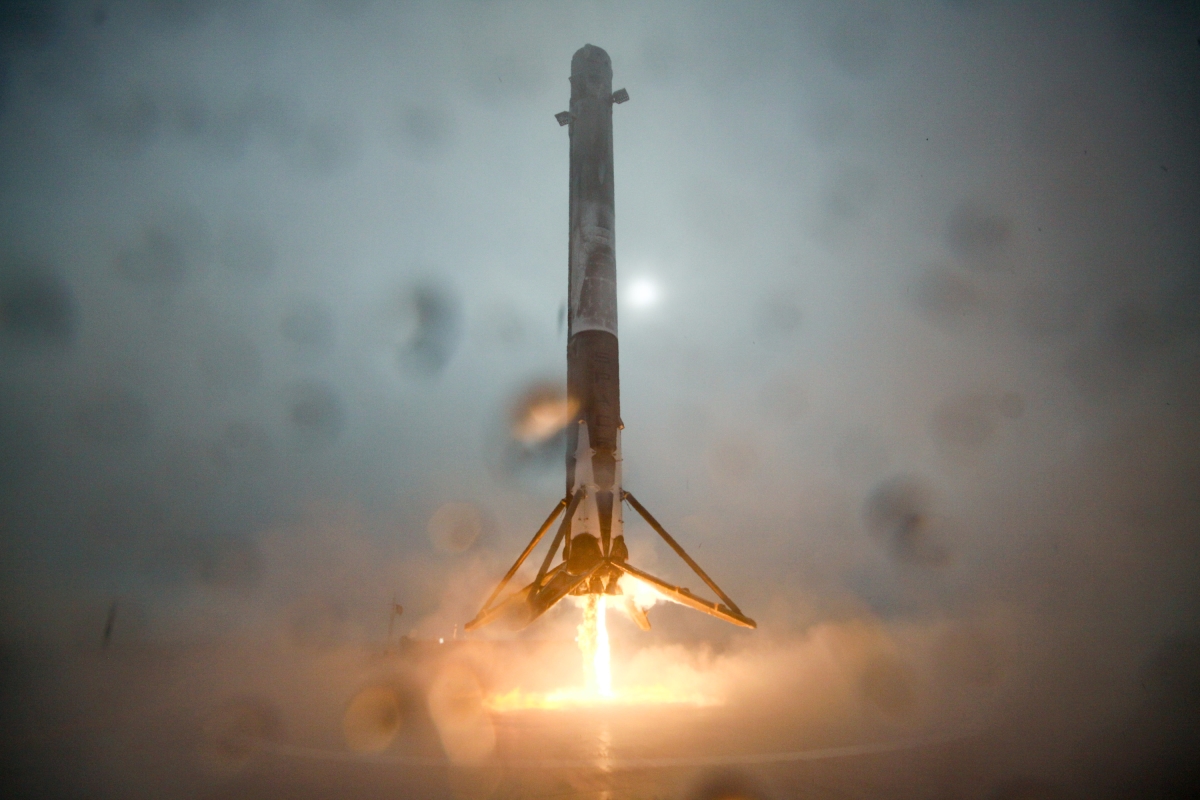Remembering the Space Race
First stage of a Jason3 rocket approaches center of landing droneship in Pacific Ocean. Space X is one of several companies that are renewing a space races; this time between companies rather than countries. (SpaceX)
April 28, 2017
The United States may have landed a man on the moon nearly 50 years ago, but the space race has stayed interesting ever since.
When the Soviet Union launched Sputnik into space on October 4th, 1957, they started one of the longest technological advancement races in human history. Until its epic conclusion with the Apollo 11 mission, which successfully landed two men on the moon, the United States and the Soviet Union pushed themselves to their breaking points. Although the Cold War was arguably the most dangerous time in recent history, humanity and science greatly benefitted from it in the long run. From advanced military technologies to scientific breakthroughs, the space race’s influence is still being felt today.
1957 – 1960
With the successful launch of Sputnik 1, the first manmade object to reach space, then-President Dwight D. Eisenhower coined the term Sputnik-crisis. Americans felt genuine fear at the perceived technological superiority of the Soviet Union, especially after its first atomic bomb detonation in 1949 and rapid post-World War II remilitarization. The rocket technology that launched the first man-made satellite into space had the capability to launch missiles and other weapons all the way to the American mainland, a possibility which terrified the American government. While a direct attack was very possible, the possibility of espionage was a much more significant threat.
While the satellite itself had few capabilities beyond measuring and sending simple signals, the Soviet Union had plans to optimize satellites and hopefully win the Cold War. In the following months and years, several other programs were created, including the Soviet Luna project, which became the first man-made object to land on the moon.
While the Soviet Union was making steady advancements in space, the United States was catching up. NASA, which had been established in 1958 specifically to focus on the space race, was still in its infancy, and struggled to compete with the Soviet Union’s space program. NASA did manage to successfully send several unmanned craft to space during this time, and even sent two primates into orbit.
1961 – 1964
On April 12th, 1961, Soviet pilot Yuri Gagarin became the first man to ever travel to space. He completed a full orbit of the earth during his flight, and reentered the atmosphere one hour and 48 minutes later.
One month later on May 5th, Alan Shepard became the first American man in space. He spent only 15 minutes in a suborbital flight, meaning he never completed a full orbit of the earth before returning home.
On May 25th, 1961, President John F. Kennedy announced to Congress his vision to land a man on the moon before the end of the decade. In a speech to Rice University on September 12th 1962, Kennedy spoke the now famous line, “We choose to go to the moon in this decade and do the other things, not because they are easy, but because they are hard.” Unfortunately, Kennedy would never see his vision come to life before his untimely assassination on November 22nd, 1963. Kennedy’s death spurred his successor Lyndon B. Johnson to heavily promote the Apollo program, which eventually landed several missions on the moon.
In 1963, Soviet cosmonaut Valentina Tereshkova became the first female to visit space, doing so for nearly three days. Her time in space was longer than the combined time of all astronauts before her.
1965 – 1968
The Soviet Union pulled ahead of the United States near the end of the space race. The Union successfully completed the first purposeful moon landing, though it was unmanned, and cosmonaut Alexei Leonov pulled off humanity’s first space walk. Probes went into orbit around the moon and Venus, stretching the Soviet list of achievements even further.
Meanwhile, the United States was still struggling to compete. While the Soviet Union spread its attention across the entire solar system, NASA had its eyes on one thing: landing men on the moon, and bringing them back alive. Three astronauts testing the Apollo 1 capsule suffocated and burned alive in a test facility, and several test rocket launches were unsuccessful. At the time, it appeared that the United States would not be able to match the interstellar might of the Soviet Union.

Credit: NASA
In 1968, however, NASA began to hit its stride. Several missions sent Americans into space, including the completion of a full orbit of the moon by three astronauts in Apollo 8. Pressures were high on NASA director James E. Webb to meet the late president Kennedy’s wish to land on the moon before 1970, pushing the program to its limit.
1969 – 1972
1969 arguably marks the end of the end of the space race. On July 20th, Apollo 11 astronauts Neil Armstrong and Buzz Aldrin became the first men to walk on the moon. Throughout the next three years, Apollo 12, 14, 15, 16, and 17 all landed on the moon and successfully came home.
Russian cosmonauts never reached the moon; botched rocket launches and budget cuts ended plans to match the United States on the moon by 1973. The last manned mission to the moon, Apollo 17, departed the solar surface on December 14th, 1972. Humanity has not travelled that far from earth since.
1973 – present
Since the conclusion of the space race, and the subsequent dissolution of the Soviet Union in 1991, the United States and Russia have combined their powers to expand scientific research and knowledge of space together. Along with other organizations around the world, the International Space Station (ISS) was launched in 1998, and collaborations have sponsored countless discoveries.
Unfortunately, the station is becoming obsolete. Like other stations before it, the ISS is slated to be decommissioned sometime in the 2020s. The station’s operational life ends in 2020, and it is unlikely that any program will be willing to maintain it past that date.
Despite this, the future looks bright for space travel. Private companies such as SpaceX and Virgin Galactic are creating technologies that could potentially push humanity past the moon. The scientific community surrounding NASA and other space agencies says that exploratory missions to the water-bearing moons of Jupiter and Saturn, or even worlds outside of our solar system, are the future of space travel; perhaps it will take another ultra-competitive space race-like situation to get us there.
A full and detailed timeline of the space race can be found here.








